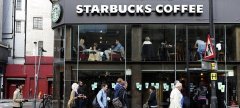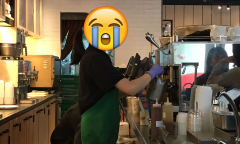Who made the money when Starbucks coffee was so expensive?
(this article was published in the 11th issue of China Economic Weekly in 2017)
If Devil Economics inspires people's minds, Harford's book is more approachable, subverts common sense and is closer to the truth. He uses the way of thinking of an economist to solve all kinds of life problems. Economic theory provides many rational solutions to deal with life problems in a quantitative or utilitarian way, which may not be so affectionate, but it is often cured by medicine.
Other economists often use such mysterious words as efficient market, monopoly, externality, information asymmetry, bounded rationality, game theory and globalization to explain the world. As an undercover, Harford uses the tools of economists and research tools to explain how the social system works, how companies profit from it, and how you should fight back as a consumer.
Tim. Harford.

"undercover Economics" series
Recommended index: ★
Author: Tim. Harford.
(Tim Harford)
Publishing: Citic Publishing Group
Brief introduction of the author:
Tim. Harford (Tim Harford)
He worked at the World Bank, served as an economics professor at Oxford University, and served as chief economist for a well-known international financial company. Now, he is a famous undercover economist who is highly sought after by readers all over the world, and is known as "the most humorous master of life economics". His "Dear Economist" column is one of the most watched columns in the history of the Financial Times, in which he uses the latest economic theory to provide readers with a relaxed and witty economic interpretation of a wide variety of questions and complaints.
Whether you live in New York, Tokyo, Antwerp or Prague, commuting through the public transport system is common as long as it is a big city. This exhausting shuttle has both commonality and particularity. The reason for the particularity is that each traveler is a mouse in his own unique maze: calculating the time from the bathroom to the subway station turnstile; keeping track of the train schedule so that he can choose the right platform and change trains in the shortest possible time; I would rather stand and take the first bus than wait for the last one because I want to get home early. However, the commuting of many people creates a common situation-traffic bottlenecks and rush hours, and businesses around the world are taking advantage of this opportunity to make money. My shuttle in Washington, D.C., is different from your itinerary in London, New York or Hong Kong, China, but how similar they are.
Farragut West Station is an excellent subway station. Every morning, bleary-eyed and upset pedestrians enter the lobby of the International Plaza from Farragut West Station. They do not like to make a detour, but there is a quiet and comfortable place to lure them for a while. Today, there is a charming barista in the coffee shop. Her name on her name tag is Maria. Of course, the place I think of is Starbucks. Not surprisingly, the coffee shop is located at the exit of the International Plaza. This is not a special case of Farragut West Station: if you come out of the nearby Farragut Metro North Station, the first store you pass will be a Starbucks. You will find that there are cafes all over the world that have a "geographical" advantage, serving pedestrians who are equally upset. The coffee shop 10 meters from the DuPont roundabout subway station in Washington is called Cosi;. The exit from New York's Grand Central Station to eighth Avenue is next to the Seattle Coffee Company; at Shinjuku Station in Tokyo, you don't have to leave the station square to enjoy a Starbucks service; at London's Waterloo subway station, the exit to the south bank of the Thames is guarded by AMT's commissary.
At Starbucks, a large cappuccino for $2.55 is not cheap. But of course I can afford it. Like many people who stay in this coffee shop, I can earn money for this cup of coffee in a few minutes. Few people are willing to look around for a cheaper cup of coffee at 08:30 in the morning, just to save a few cents. There is a great demand for convenient coffee-at Waterloo subway station, for example, the annual flow of people is 74 million, which makes the location of the coffee shop extremely critical.
Starbucks at Farragut West Station is well placed, not only because it is located on the key line from the platform to the subway exit, but also because it is the only coffee shop on the line. No wonder their business has been booming.
If you buy this kind of coffee as often as I do, you might think: someone must have made a fortune out of it. If the occasional complaint in the newspaper is correct, the coffee in this cappuccino is only worth a few cents. Of course, the newspaper didn't tell the whole story: the cost of milk, electricity, paper cups, and the cost of asking Maria to smile at the grumpy guests. But even if you add up all these costs, the value is still much lower than the price of a cup of coffee. According to Brian, an economics professor. McManus calculates that coffee has a profit margin of about 150%. Drip coffee costs 40 cents for a cup of drip coffee for $1, while a small latte for $2.55 costs less than $1. So someone must have made a lot of money out of it. Who on earth is it?
You may think of an obvious candidate: Howard, the boss of Starbucks. Howard Schultz, but the answer is not that simple. Starbucks priced a cappuccino at $2.55 mainly because there was no other coffee shop next door that sold $2 a cup. So why isn't there anyone else next door to rob Starbucks? I don't want to belittle Mr. Schultz's achievements, but to be honest, cappuccino is not a complex product. There is no shortage of good cappuccinos (nor, unfortunately, bad cappuccinos). Others don't cost much: buy a few coffee machines and a counter, spend some advertising money, give some free products to make the brand sound, hire decent staff, and even Maria can be replaced.
The truth is that Starbucks' most obvious advantage is its location, with thousands of pedestrians shuttling back and forth and eager to buy. There are not many ideal locations for coffee shops-subway station exits or intersections of busy streets. Starbucks and its rivals are already keeping an eye on them. Starbucks cappuccino has considerable profit margins, neither because of the quality of coffee, nor because of its employees, the most important factor is location, location.
But who controls the position? Look at the negotiator at the beginning of the new lease agreement. The landlords of the International Plaza will not only interview Starbucks, but also chain stores such as Cosi and reindeer coffee. Landlords can sign an agreement with each of them, or they can sign an exclusive agreement with only one of them. It soon discovered that no one was willing to pay high fees for the 10 cafes next door, so it raised the price of an exclusive agreement to the highest price.
To figure out who made most of the money, just think on both sides of the table: at least six competing companies on one side and a landowner with an ideal location for a coffee shop on the other. As long as those companies are allowed to compete with each other, the landlords will be able to determine the terms of the contract and force one of them to pay a high rent, which will offset most of the profits they expect. Successful companies are expected to make some profits, but not too high. If the rent is low, leaving a huge profit margin, then another coffee shop will be happy to offer a higher price for the position. The number of coffee houses can continue to increase, but the number of attractive locations is limited-which means that landowners have the upper hand in negotiations.
This is just talk on paper, and we have reason to ask whether it is in line with reality. I once explained all the relevant principles to a friend who had suffered for a long time (from coffee), and she asked me if I could prove it. I admit it's just a theory-- Sherlock. In this case, Holmes would say that this is a "inferential deduction" based on the clues we can get. A few weeks later, she sent me an article in the Financial Times based on the advice of industry experts who could see the coffee company's books. The article began to write that "few companies make money", and the main problem is that "the cost of running a retail store in an important location with a lot of people flow is too high." Checking the ledger is a tedious task, and the work of an economic detective can easily come to the same conclusion.
(this article is excerpted from the body of the book, the content has been deleted and revised, and the title is added by the editor)
Important Notice :
前街咖啡 FrontStreet Coffee has moved to new addredd:
FrontStreet Coffee Address: 315,Donghua East Road,GuangZhou
Tel:020 38364473
- Prev

Queuing is a business model for Starbucks, and so is queuing.
Do today's urban white-collar female elites have to bring a Starbucks into the company in the morning? Just hold a cup and the momentum will come out. In their eyes, the cup is armor, a sword, and Moses himself who can separate the Red Sea. Just last week, we reported that Starbucks' same-store transaction volume in the United States fell by 2% in the first quarter of this year due to mobile orders. There are too many customers in line.
- Next

A cup of coffee has a story! Hong Kong baristas talk about the bitter history of entering the profession
Like the editor, more and more people like to drink coffee, and many coffee lovers have joined the ranks of baristas. The barista is neatly dressed and stands in the water bar to make coffee, just like the barista in the South Korean TV series Coffee Prince one. But in fact, there is a lot of bitterness behind my back, and there is blood and sweat in a cup of coffee! Hong Kong barista tells the story of 7 unknown bitterness
Related
- What documents do you need to go through to open a coffee shop? coffee shop coffee shop certificate processing process
- How to purchase Coffee beans in small Cafe how to choose a suitable supplier for domestic Coffee supply Company
- How to drink Starbucks Fragrance White Coffee? how to make Australian White Coffee? what Italian coffee beans are recommended?
- The Story of Flora Coffee: the name of Flora Coffee Bean and the implication of the Flowers on Florna Coffee
- How much does a cup of coffee cost? How much is the profit of a cup of coffee? What is the profit of the coffee shop in a year?
- Yunnan small Coffee, known as "fragrant Coffee", introduces the characteristics of Alpine Arabica Coffee producing areas in Yunnan, China
- 2023 latest Starbucks full menu price list how much is a cup of Starbucks coffee what is better to drink the most popular hot and cold drinks recommended
- Starbucks different kinds of Coffee Price list Starbucks menu 2023 Top Ten Best drinks in Starbucks
- Starbucks Spring praise Comprehensive matching Coffee Bean theme Story Packaging implication and taste description
- The cost of a cup of coffee latte American coffee cost price and selling price

